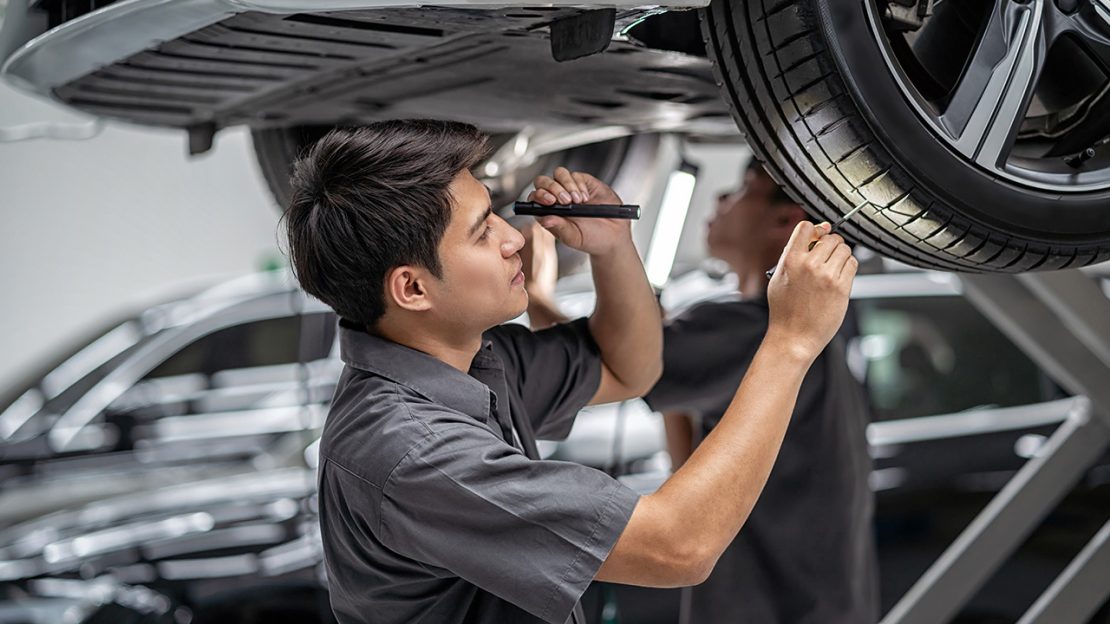Electric vehicle sales have exploded on a year-by-year basis over the past half decade, and for good reason. Not only do electric vehicles save drivers thousands of dollars each year on gas costs—they also help owners save big on service and maintenance expenses. Electric vehicle powertrains have much fewer parts than their internal combustion counterparts. For example, electric vehicles do not require spark plug replacements, oil changes, or gas filter changes. They also do not have mufflers, catalytic covers (an expensive part with serious theft issues), fuel pumps, or fuel injectors.
However, with this new and exciting technology comes an entirely new set of challenges regarding servicing these vehicles, and it’s crucial that technicians know what to look for when providing electric vehicle service.
Going Beyond Regular Battery Maintenance
The battery of your electric car is essentially the engine that powers the entire vehicle. It is the costliest, heaviest, and most significant component of an electric car, and should be cared for as such. Battery replacements typically start at around $3,000 and can reach all the way up to $20,000 for more long-range and high end batteries.
While there are practices an owner can take to prolong the life of a battery, such as keeping the charge between 20% and 80% and not exposing the battery to extreme heat or cold, an electric vehicle service provider must invest in special equipment and training.
Certified electric vehicle service providers can facilitate specialized equipment to complete tasks such as checking battery filler openers and connections, determining the battery’s cycle count, assessing battery fluid levels, and more. These parts and tools can cost a dealership thousands in training and handling but are also required by many manufacturers in order to handle their electric vehicles.
Fluid Changes
Electric vehicles use considerably less fluids than internal combustion engines. For example, you usually won’t find transmission fluid in an electric vehicle, which is a huge cost and peace of mind benefit for owners. However, this puts even more emphasis on the fluids that do exist within the vehicle. The two most important fluids that an electric vehicle service provider needs to be inspecting at every maintenance check are the coolant and brake fluid.
In a gas engine, the coolant aids in temperature regulation in your vehicle, playing a huge role in preventing the engine from overheating. Coolant serves a similar purpose in an electric vehicle, as it helps operate cooling plates that can be found underneath the battery pack. Keeping the battery at an optimal temperature increases its rechargeability and longevity, making coolant fluid levels of crucial importance.
Managing The Brakes
Electric vehicles facilitate regenerative braking systems, which use motor resistance to help slow the car and transfer energy back into the battery. They still use friction brakes, but they typically last far longer than the brakes on a gas-powered car due to the regenerative braking system putting less stress on the brake pads. In a gas-powered car, the brakes usually last 25,000 to 65,000 miles, while they are expected to last at least 100,000 miles in an electric car.
Some electric vehicles have such efficient and strong regenerative brakes that they make friction brakes unnecessary in most situations and the driver can perform what is called “one pedal driving.” While this type of driving seems like an all-around win, it can have significant drawbacks. Most importantly, rust and corrosion can occur within the friction brakes due to a lack of use. If the rust gets bad enough within the caliper, it can cause the friction brakes to seize and fail entirely.
When performing electric vehicle service on the brakes, technicians should pay close attention to both the regenerative and friction brakes, regardless of their age and mileage. Rusting can occur within the rotors, pads, and calipers and fluid can get old and decay. All these components must be regularly checked on an electric vehicle and changed if necessary. It is also valuable to teach electric vehicle owners to pump their friction brakes often to keep them rust free and fresh.
Conclusion: Stay Ahead of The Curve
As electric vehicle ownership continues to grow at a rapid pace, innovative electric vehicle technologies will evolve. While electric vehicles are expected to require fewer maintenance and service visits than gas vehicles, these visits are more complex and involved for technicians. Specific equipment will be required to perform some electric vehicle service, and specialized training will be mandatory for the technicians to learn the nuances of these technologically advanced vehicles. The investment in equipment and training to perform the best electric vehicle service possible will be a worthwhile one, as electric vehicles continue to break annual sales records.
Elo GPS with CarRx is a vehicle maintenance app that is designed with dealers and service departments in mind. CarRx simplifies the customer communications process, tracks and schedules service and maintenance visits, and increases customer retention and satisfaction.
Contact us today to explore setting up your dealership with this smart technology that will help you grow in the rapidly evolving vehicle industry.

